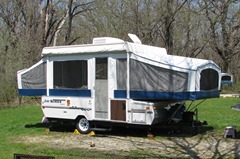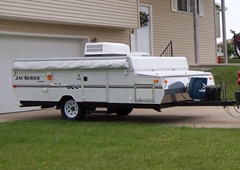Popup campers are lightweight, towable RVs that fold or collapse into a more compact form – generally a hard side box base unit – for travel and storage. They are a great upgrade from tent camping, with more comfortable sleeping and better protection from the elements than most tents, often along with many conveniences found in other RVs.
Popup campers are also referred to as tent campers, tent trailers, folding campers, folding camping trailers, soft-side campers, and fold down campers.
Note: Telescoping and hybrid campers are included with travel trailers.
A conventional pop-up consists of a trailer frame, a box, a hard roof, pull-out bunks and “soft” walls. The walls are made of vinyl, canvas or a similar material and include windows with screens.
Basic popups usually include the following features: fold-down dinette (table top and bench seating combination), on-board fresh water tank, sink, 12-volt DC power system (including an AC to DC converter and a deep cycle battery), interior DC lighting, two sleeping bunks and storage cabinets. Many pop-ups also include a gas/electric absorption refrigerator, stove, rooftop air conditioner, propane furnace, water heater, electric water pump, exterior shower, skylight/roof vent, one or two propane tanks, electric or surge brakes, large storage trunk at the front of the box, and an awning. Some premium models also include a shower, toilet, wastewater tanks, slide-out section (to increase interior space), microwave, and an oven.
Since space is at a premium in popup campers, it is common for a single structure to serve multiple purposes. Generally, the dinette, which can seat four people for a meal, can be converted into a bed to provide additional sleeping space. Likewise, the couch, if present, can usually be folded down into a bed. Often, the inside table (part of the dinette) and the gas stove can be taken outside and attached to the side of the camper. 1
When set up, this type of camper provides a large amount of interior space compared to its travel size. The camper box ranges from 8 to 18 feet in length. Popups, with the top raised and the sleeping areas slid out can be almost 30 feet in length, depending on the size of the popup box.3 Accessories such as screened extensions can add additional living space.
Due to their lower prices, popup campers are often the entry level purchases for first time RVers.
Since most popup campers have soft walls, they weigh less than most other towable RVs. Their smaller profile and lighter weight makes popups easier to tow than larger towable RVs.1 Popup campers models are available sized for almost any car to be able to tow, though camper and tow vehicle must be carefully matched to ensure that the tow vehicle’s tow ratings are not exceeded.
With their low-profile, popup camper towing is easier than larger travel trailers, plus, since the folded down popup doesn’t obstruct the drivers rear view, there usually is no need for special side view mirrors. As well, the folded down popup is easier to store, easily fitting into most garages.3
There are some downsides unique to popups.
Though easier than tent camping, popup setup time and takedown for popups is generally longer than what is needed for other towable RVs and motorhomes.4 This is more difficult in inclement weather and, even when set up, string winds will rock the camper with unwelcome breezes through the fabric sides.
Lack of privacy. “It’s hard to get much privacy in a pop-up camper. Even the bathroom (not available in all pop-ups) is usually only enclosed by a curtain or a thin wall that is definitely not soundproof.”3
When done camping, it’s important to dry off all areas – inside and out – of the pop-up. With the popup’s fabric folded and compacted for towing and storage, moisture can result in growth of mold and mildew, leaving a nasty surprise for the next camping trip.
Variations from the “standard” popup:
- High wall pop-ups – feature a taller box which allows for residential-height countertops and more storage space.
- Motorcycle campers – lightweight pop-ups small enough to be pulled by a motorcycle.
- Toy hauler pop-ups – include an open cargo deck for transporting ATVs, motorcycles, etc.
- Off road pop-ups – feature rugged construction and raised suspension for off road use.
- A-frame – small solid wall folding camper.
- Flip-out camper – features a roof which flips over to become a bunk. Uses a tent roof instead of a hard roof.
Sources:
1 Wikipedia – Popup camper
2 Wikimedia – JaycoPopupCamper-2009-11-17.jpg by Korey99; licensed under the Creative Commons Attribution-Share Alike 3.0 Unported license.
3Camping Earth – Popup Campers
4Wikipedia – Popup camper; Setting up
5Wikmedia – Recreational vehicle from Core Banks, North Carolina by Jarek Tuszynsk; licensed under the Creative Commons Attribution-Share Alike 3.0 Unported license.
For more information:
- Popup Camper (Wikipedia)
- Popup Campers (Camping Earth)
- Pop-Up Tent Trailers (Outdoor Camping Guide)
- Popup Camper History

Popup Camper Manufacturers
(with listings of current models)
Aliner – models: Classic, Expedition, Ranger 10, Ranger 12, Ranger 15, Scout
Bunkhouse Trailers – models: LX, Queen
Chalet RV – models: Alpine, Arrowhead, Aspen, LTW, XL
Coachmen – models: Clipper, Viking
Coleman – new models marketed exclusively by Camping World
Forest River – models: Flagstaff, Rockwood
Jayco – models: Baja; Jay Series; Jay Series Sport
Kamparoo Campers – models: Trans-Continental Kit (offroad), Vacationer
Lees-ure Lite – pull behind a motorcycle or a car (sold in the US southeast by Lite Tent Camper)
Livin’ Lite Recreational Vehicles – models: Quicksilver 6.0, Quicksilver 8.0, Quicksilver 10.0, Quicksilver 18SUT, Quicksilver XLP
Palomino – model: Basecamp
Safari Condo – A teardrop that pops up; models: Alto F-Series, Alto R-Series
Starcraft – models: Comet, Comet Hardside, Starflyer
SylvanSport – model: Go (more info)





